Assessment of Heating and Cooling of a Spontaneous Fire Source in Coal Deposits—Effect of Coal Grain Size
Abstract
:1. Introduction
2. Materials and Methods
3. Results
4. Conclusions
- −
- For the heating phase, the dispersion of average values of the gases tested between coals subjected to standard and coarse crushing were the highest for ethane and propane, while the lowest for hydrogen, carbon monoxide and acetylene. For the cooling phase, the distribution of average values between standard and coarse coal grains were also the highest for ethane and propane, while the lowest for carbon monoxide and hydrogen.
- −
- The average values of differences between standard and coarse coal grains were lower for the heating phase than for the cooling phase.
- −
- Coal crushing had a significant impact on the differences in gas concentration, which directly translates into an assessment of the fire hazard both during heating and cooling of coal. The selected fire indices are calculated on the basis of the amounts of gases released from crushed coal in a function of temperature. These indices are employed in determination of self-heating temperatures of coal in a coal mine. The determination and selection of a proper coal grain sizes of coal samples tested is important in terms of the representativeness of the results of these analyses which have been proven in the study presented and should be the subject of further research. The laboratory scale testing of coal samples crushed to the degree reflecting the natural coal crushing conditions in a coal mine would allow for better representation of natural conditions of the phenomena tested under laboratory conditions and would improve the correctness and the credibility of the results.
Author Contributions
Funding
Conflicts of Interest
References
- Dai, G.L. Study on the gaseous products in coal oxidation at low temperature. Coal Mine Saf. 2007, 1, 1–4. [Google Scholar]
- Singh, A.K.; Singh, R.V.K.; Singh, M.P.; Chandra, H.; Shukla, N.K. Mine fire gas indices and their application to Indian underground coal mine fires. Int. J. Coal Geol. 2007, 69, 192–204. [Google Scholar] [CrossRef]
- Adamus, A.; Sancer, J.; Guranova, P.; Zubicek, V. An investigation of the factors associated with interpretation of mine atmosphere for spontaneous combustion in coal mines. Fuel Process. Technol. 2011, 92, 663–670. [Google Scholar] [CrossRef]
- Beamish, B.B.; Arisoy, A. Effect of mineral matter on coal self-heating rate. Fuel 2008, 87, 125–130. [Google Scholar] [CrossRef]
- Kuchta, J.M.; Rowe, V.R.; Burgess, D.S. Spontaneous Combustion Susceptibility of U.S. Coals; Bureau of Mines Report of Investigation; RI-8474; U.S. Department of the Interior, Bureau of Mines: Pittsburgh, PA, USA, 1980; Volume 37. [Google Scholar]
- Kaji, R.; Hishinuma, Y.; Nakamura, Y. Low temperature oxidation of coals: Effects of pore structure and coal composition. Fuel 1985, 64, 297–302. [Google Scholar] [CrossRef]
- Ren, T.X.; Edwards, J.S.; Clarke, D. Adiabatic oxidation study on the propensity of pulvirized coal to spontaneous combustion. Fuel 1999, 78, 1611–1620. [Google Scholar] [CrossRef]
- Nugroho, Y.S. Low-temperature oxidation of single and blended coal. Fuel 2000, 79, 1951–1961. [Google Scholar] [CrossRef]
- Beamish, B.B.; Barakat, M.A.; George, J.D. Spontaneous-combustion propensity of New Zealand coals under adiabatic conditions. Int. J. Coal Geol. 2001, 45, 217–224. [Google Scholar] [CrossRef]
- Zhu, Y.; Wang, D.; Shao, Z.; Xu, C.; Zhu, X.; Qi, X.; Liu, F. A statistical analysis of coalmine fires and explosions in China. Process Saf. Environ. 2019, 121, 357–366. [Google Scholar] [CrossRef]
- Taraba, B.; Pavelec, Z. Investigation of the spontaneous combustion susceptibility of coal using the pulse flow calorimetric method: 25 years of experience. Fuel 2014, 125, 101–105. [Google Scholar] [CrossRef]
- Yuan, H.; Restuccia, F.; Richter, F.; Rein, G. A computational model to simulate self-heating ignition across scales, configurations, and coal origins. Fuel 2019, 236, 1100–1109. [Google Scholar] [CrossRef]
- Wu, D.; Schmidt, M.; Berghmans, J. Spontaneous ignition behaviour of coal dust accumulations: A comparison of extrapolation methods from lab-scale to industrial-scale. Proc. Combust. Inst. 2019, 37, 4181–4191. [Google Scholar] [CrossRef]
- Janès, A.; Vignes, A.; Dufaud, O. Ignition temperatures of dust layers and bulk storages in hot environments. J. Loss Prevent. Process 2019, 59, 106–117. [Google Scholar] [CrossRef]
- Mao, Z.; Zhu, H.; Zho, X.; Sun, J.; Wang, Q. Experimental study on characteristic parameters of coal spontaneous combustion. The 9th Asia-Oceania symposium on fire science and technology. Procedia Eng. 2013, 62, 1081–1086. [Google Scholar] [CrossRef] [Green Version]
- Baris, K.; Kizgut, S.; Didari, V. Low-temperature oxidation of some Turkish coals. Fuel 2012, 93, 423–432. [Google Scholar] [CrossRef]
- Kucuk, A.; Kadıoglu, Y.; Gulabogluc, M.S. A study of spontaneous combustion characteristics of Turkish lignite: Particle size, moisture of coal, humidity of air. Combust. Flame 2003, 133, 255–261. [Google Scholar] [CrossRef]
- Zhao, J.; Deng, J.; Song, J.; Shu, C.M. Effectiveness of a high-temperature-programmed experimental system in simulating particle size effects on hazardous gas emissions in bituminous coal. Saf. Sci. 2019, 115, 353–361. [Google Scholar] [CrossRef]
- Ministry of Economy (ME). Regulation of the Minister of Economy of 23.11.2016 on Work-related Safety, Conducting Mining Operations and Specialist Fire Fighting Systems in Underground Coal Mines; Ministry of Economy: Warsaw, Poland, 2016.
- Wang, H.; Dlugogorski, B.Z.; Kennedy, E.M. Coal oxidation at low temperatures: Oxygen consumption, oxidation products, reaction mechanism and kinetic modelling. Prog. Energy Combust. Sci. 2003, 29, 487–513. [Google Scholar] [CrossRef]
- Wojtacha-Rychter, K.; Howaniec, N.; Smoliński, A. The effect of coal grain size on the sorption of hydrocarbons from gas mixtures. Int. J. Energy Res. 2019, 43, 3496–3506. [Google Scholar] [CrossRef]
- Wojtacha-Rychter, K.; Smoliński, A. The interaction between coal and multi-component gas mixtures in the process of coal heating at various temperatures: An experimental study. Fuel 2018, 213, 150–157. [Google Scholar] [CrossRef]
- Howaniec, N. Combined effect of pressure and carbon dioxide activation on porous structure of lignite chars. Materials 2019, 12, 1326. [Google Scholar] [CrossRef] [Green Version]
- Howaniec, N. Development of porous structure of lignite chars at high pressure and temperature. Fuel Process. Technol. 2016, 154, 163–167. [Google Scholar] [CrossRef]
- Howaniec, N. The effects of pressure on coal chars porous structure development. Fuel 2016, 172, 118–123. [Google Scholar] [CrossRef]
- Smoliński, A.; Howaniec, N. Analysis of porous structure parameters of biomass chars versus bituminous coal and lignite carbonized at high pressure and temperature—A chemometric study. Energies 2017, 10, 1457. [Google Scholar] [CrossRef]
- Lu, P.; Liao, G.X.; Sun, J.H.; Li, P.D. Experimental research on index gas of the coal spontaneous at low-temperature stage. J. Loss Prevent. Process 2004, 17, 243–247. [Google Scholar] [CrossRef]
- Dudzińska, A.; Howaniec, N.; Smoliński, A. Experimental study on sorption and desorption of propylene on Polish hard coals. Energy Fuel 2015, 29, 4850–4854. [Google Scholar] [CrossRef]
- Dudzińska, A.; Howaniec, N.; Smoliński, A. Effect of coal grain size on sorption capacity with respect to propylene and acetylene. Energies 2017, 10, 1919. [Google Scholar] [CrossRef] [Green Version]
- Więckowski, M.; Howaniec, N.; Postnikov, E.B.; Chorążewski, M.; Smoliński, A. Changes in the distribution of temperature in a coal deposit and the composition of gases emitted during its heating and cooling. Sustainability 2018, 10, 3587. [Google Scholar] [CrossRef] [Green Version]
- Wang, J.; Zhang, Y.; Xue, S.; Wu, J.; Tang, Y.; Chang, L. Assessment of spontaneous combustion status of coal based on relationships between oxygen consumption and gaseous product emissions. Fuel Process. Technol. 2018, 179, 60–71. [Google Scholar] [CrossRef]
- Onifade, M.; Genc, B. Spontaneous combustion of coals and coal-shales. Int. J. Min. Sci. Technol. 2018, 28, 933–940. [Google Scholar] [CrossRef]
- Onifade, M.; Genc, B. A review of spontaneous combustion studies—South African context. Int. J. Min. Reclam. Environ. 2019, 33, 527–547. [Google Scholar] [CrossRef]
- Yibo, T. Sources of underground CO: Crushing and ambient temperature oxidation of coal. J. Loss Prevent. Process 2015, 38, 50–57. [Google Scholar]
- Polish Committee for Standardization (PCS). PN-ISO 5074:2002. Hard Coal—Determination of Hardgrove Milling Susceptibility Index; Polish Committee for Standardization: Warsaw, Poland, 2002. [Google Scholar]
- Polish Committee for Standardization (PCS). PN-90/G-04502:2014-11 Bituminous Coal and Lignite—Sampling and Preparation for Laboratory Analyses—Basic Methods; Polish Committee for Standardization: Warsaw, Poland, 2014. [Google Scholar]
- Cliff, D.; Hester, C.; Botinger, C. The Interpretation of Mine Atmospheres Particularly for Spontaneous Combustion, Mine Fires and Explosions; SIMTARS: Queensland, Australia, 2004. [Google Scholar]
- Ministry of Economy (ME). The Decree of the Minister of Economy of the Republic of Poland on Health and Safety, Operational Management and Specialized Fire Protection in Underground Mining Plants; Ministry of Economy: Warsaw, Poland, 2017; p. 1118.
- Rhead, T.F.E.; Wheeler, R.V. The effect of temperature on the equilibrium 2CO=CO2 + C. J. Chem. Soc. 1910, 97, 2178–2189. [Google Scholar] [CrossRef] [Green Version]
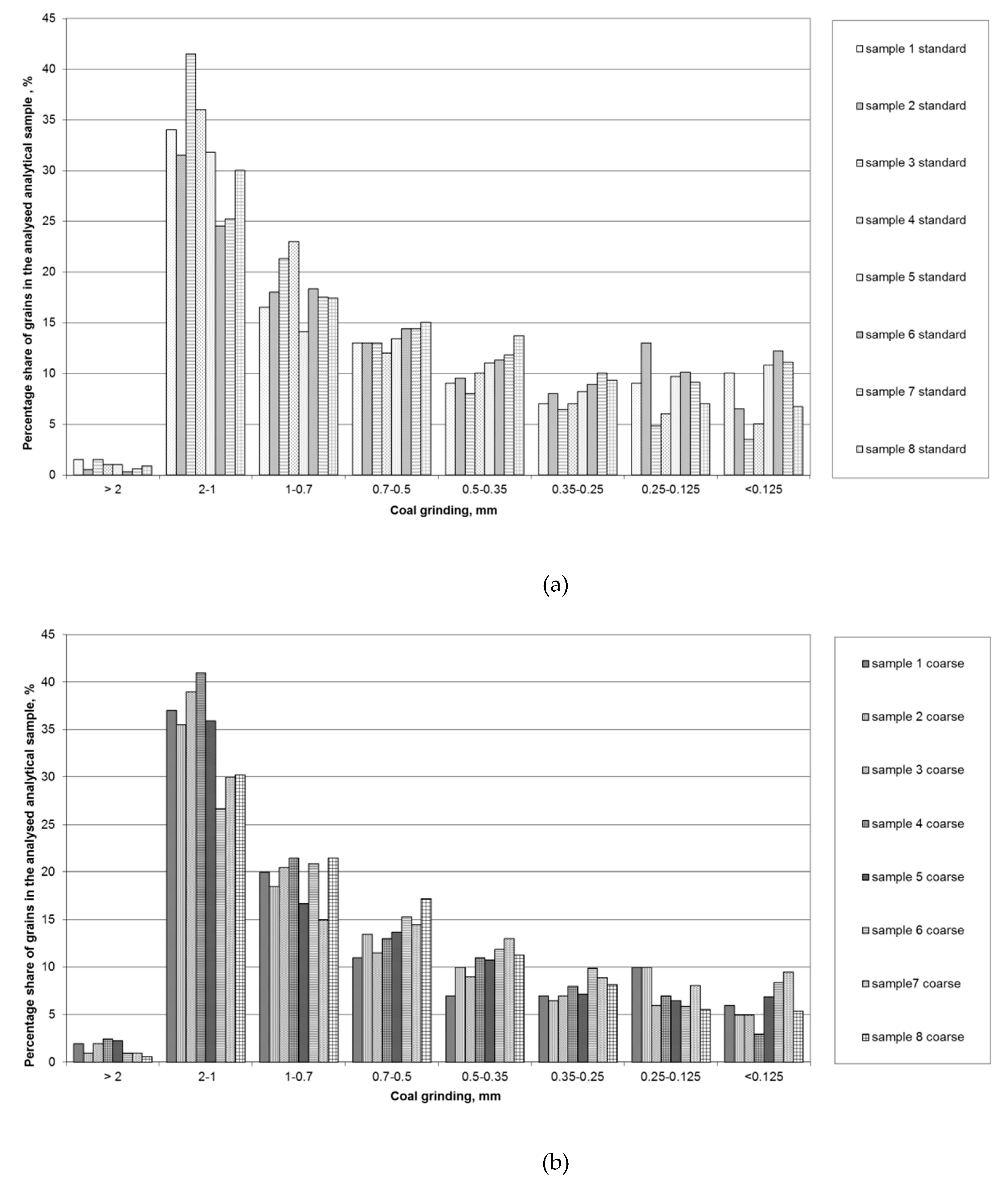
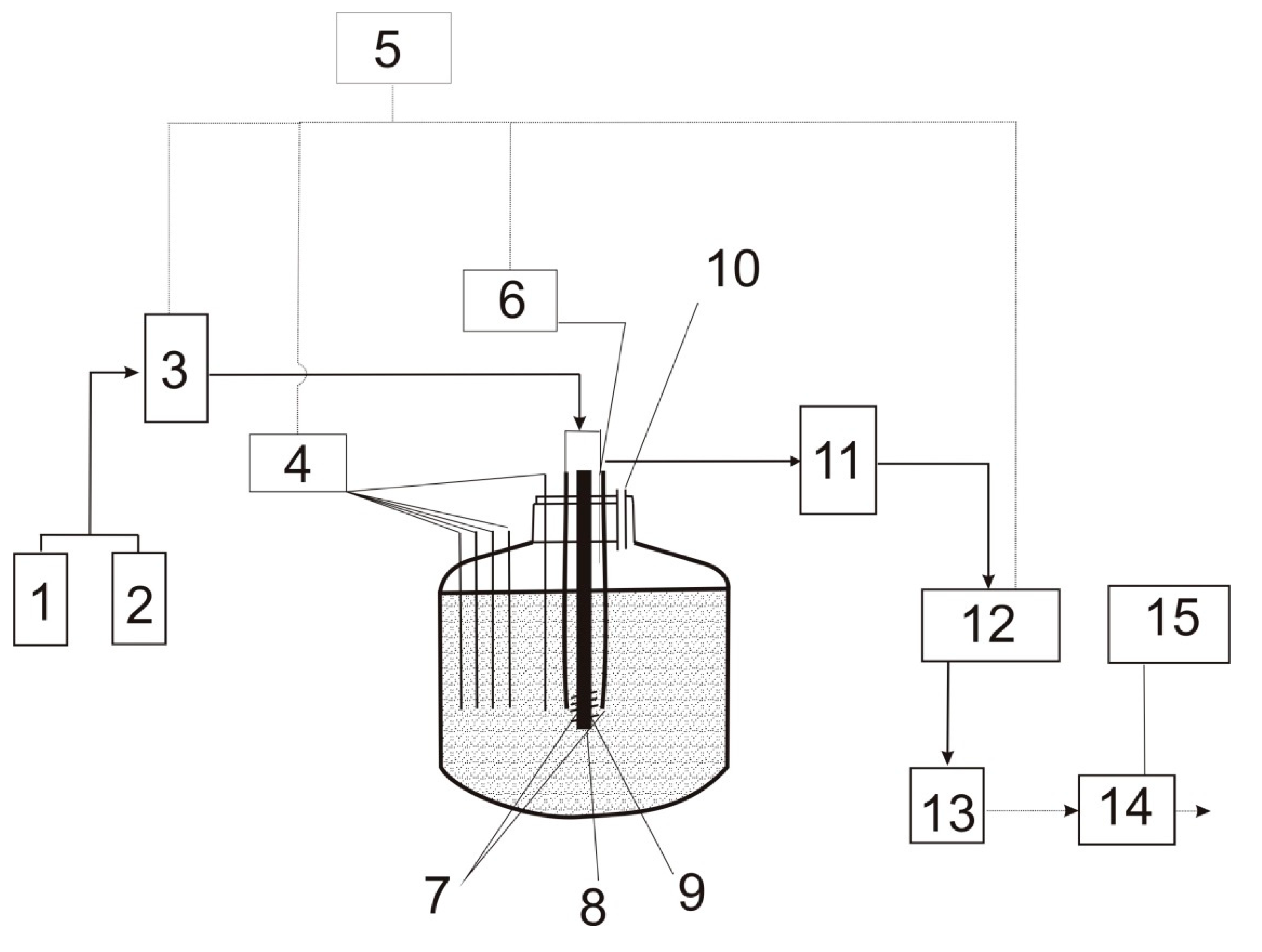
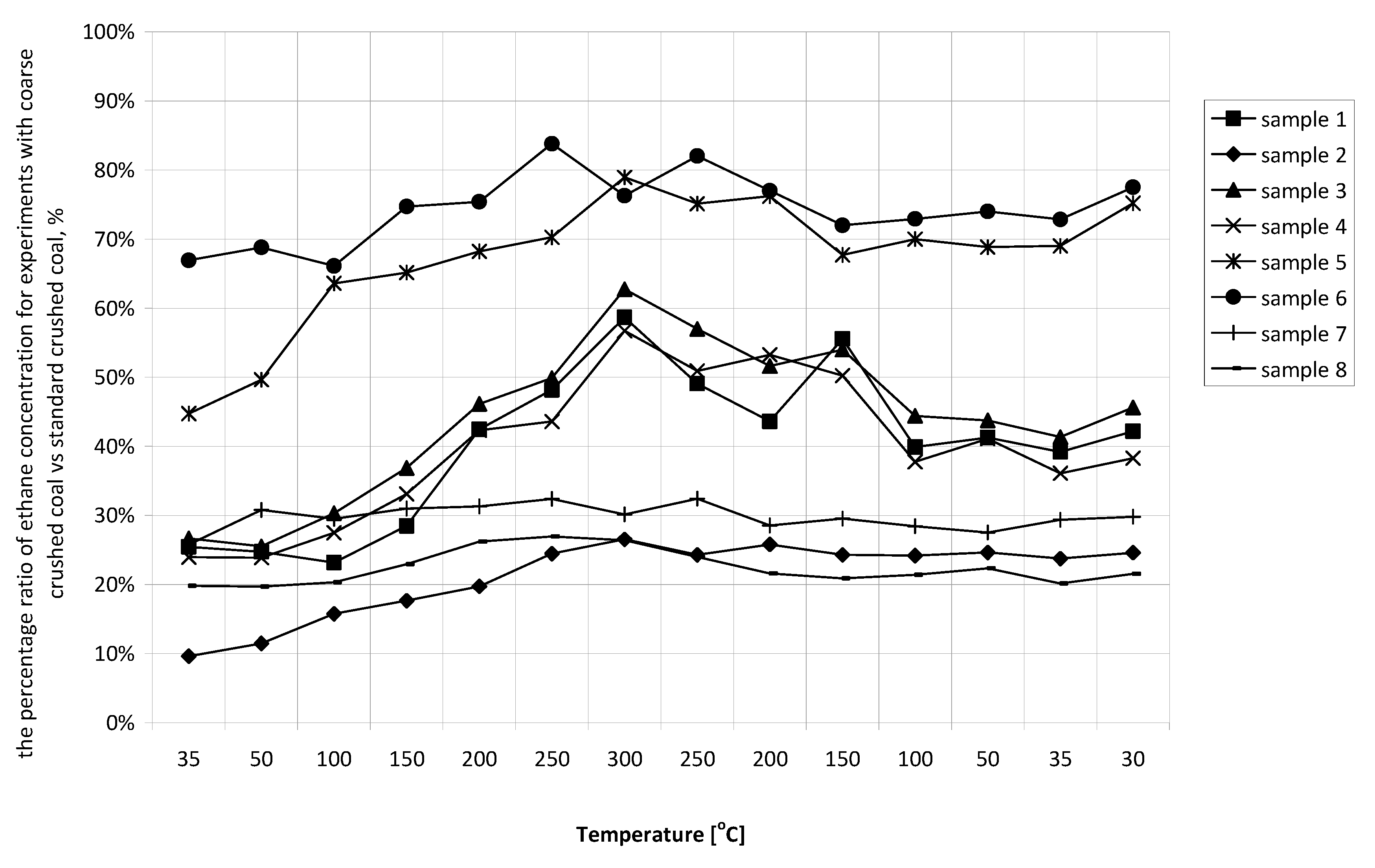
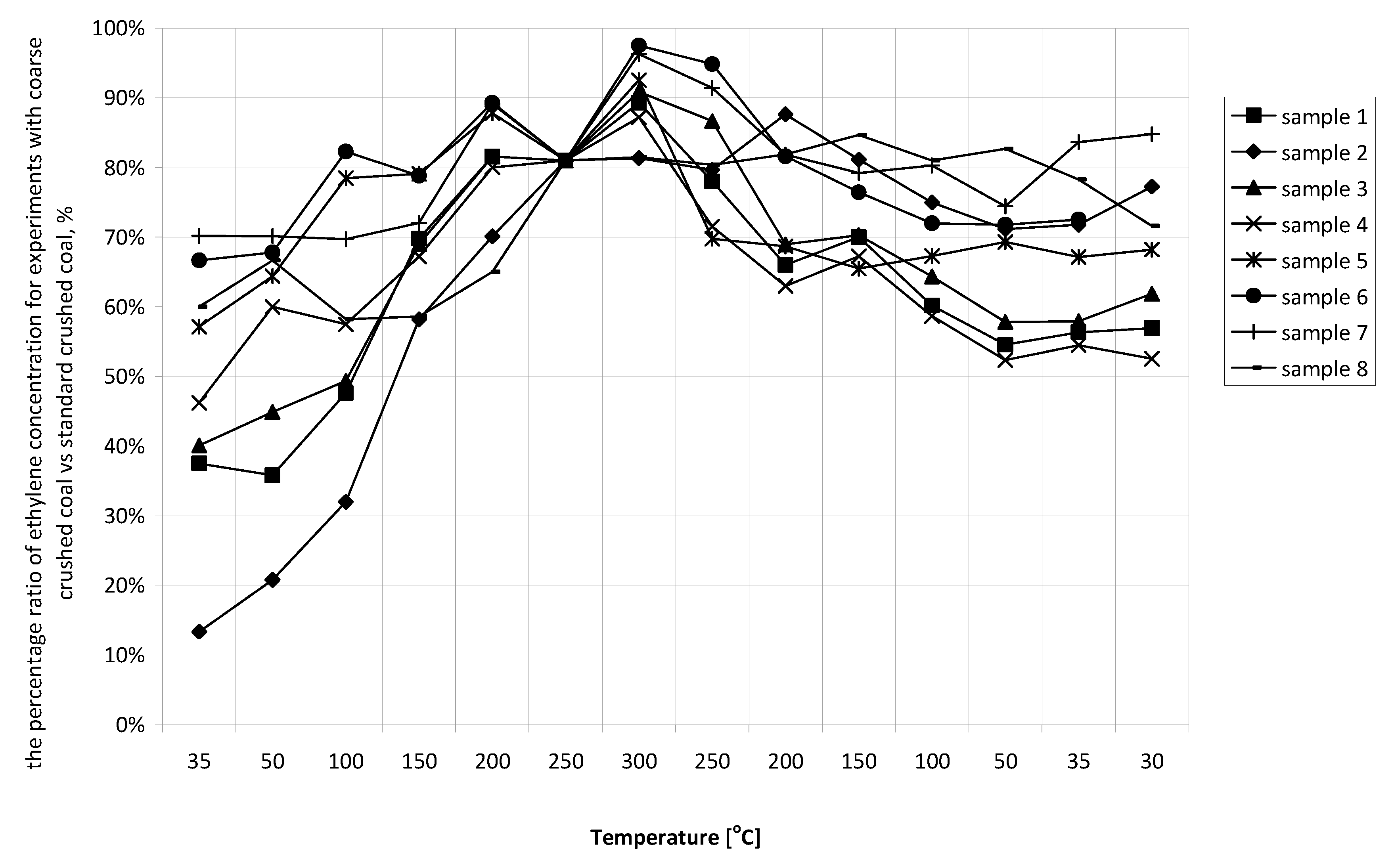
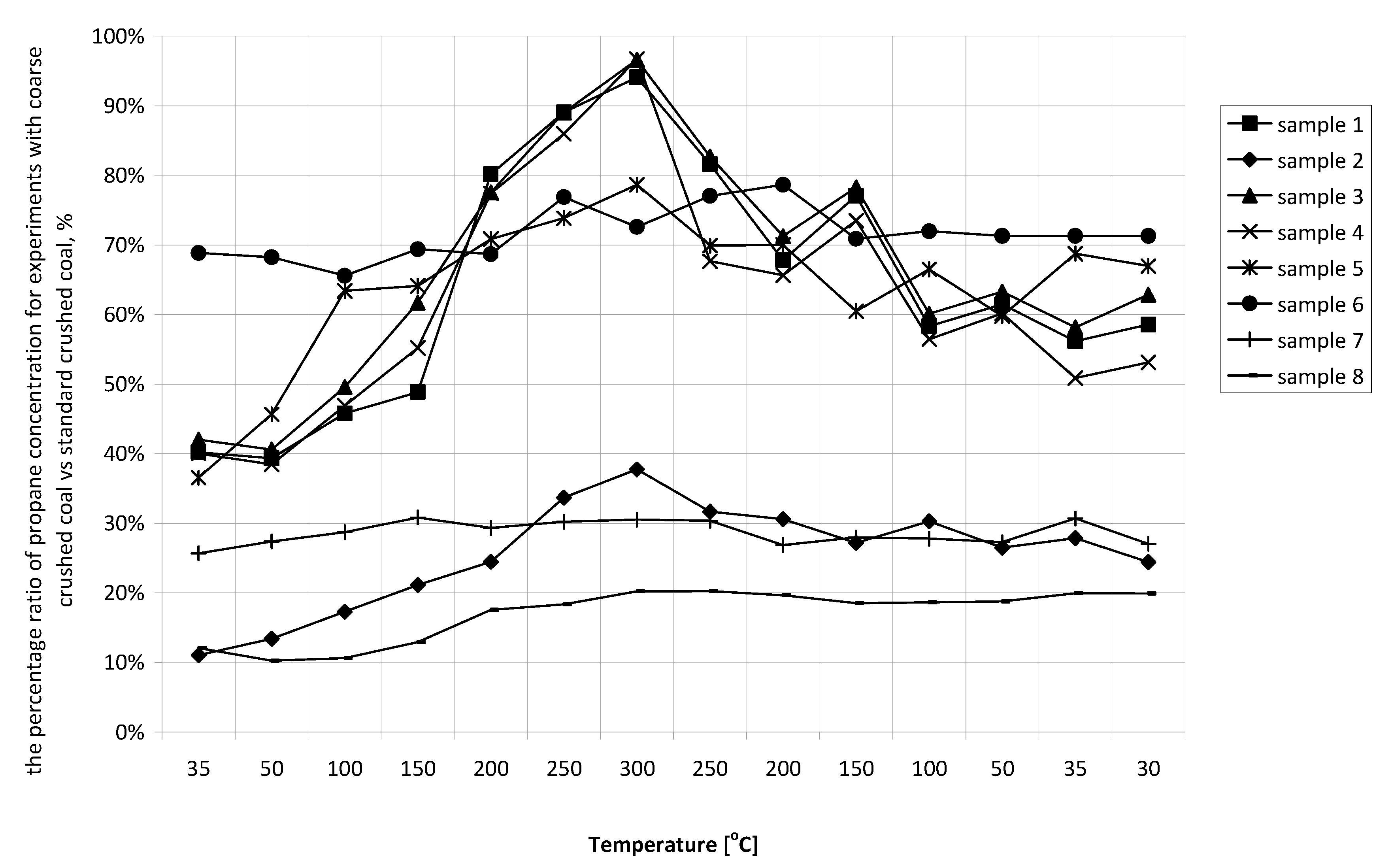

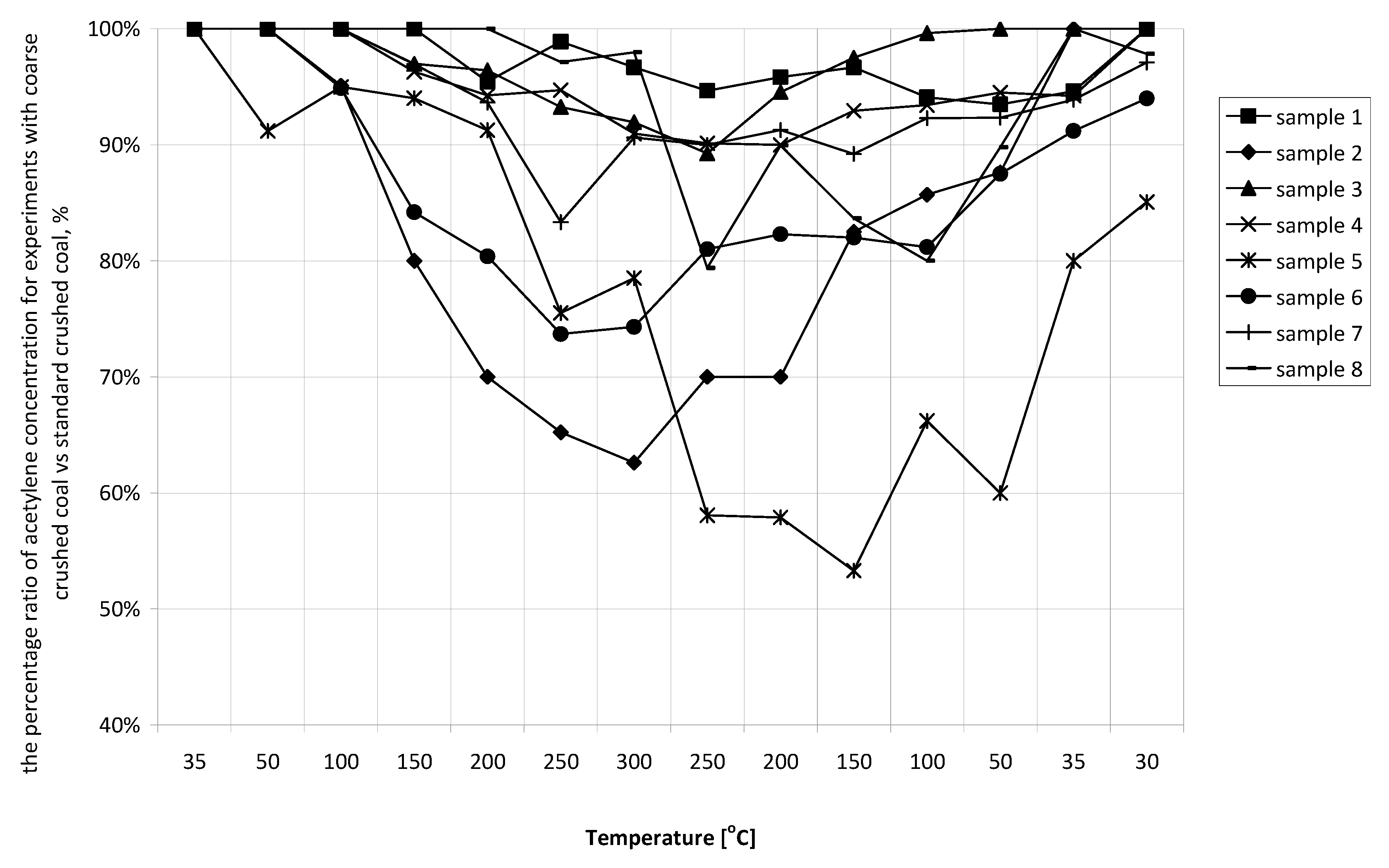
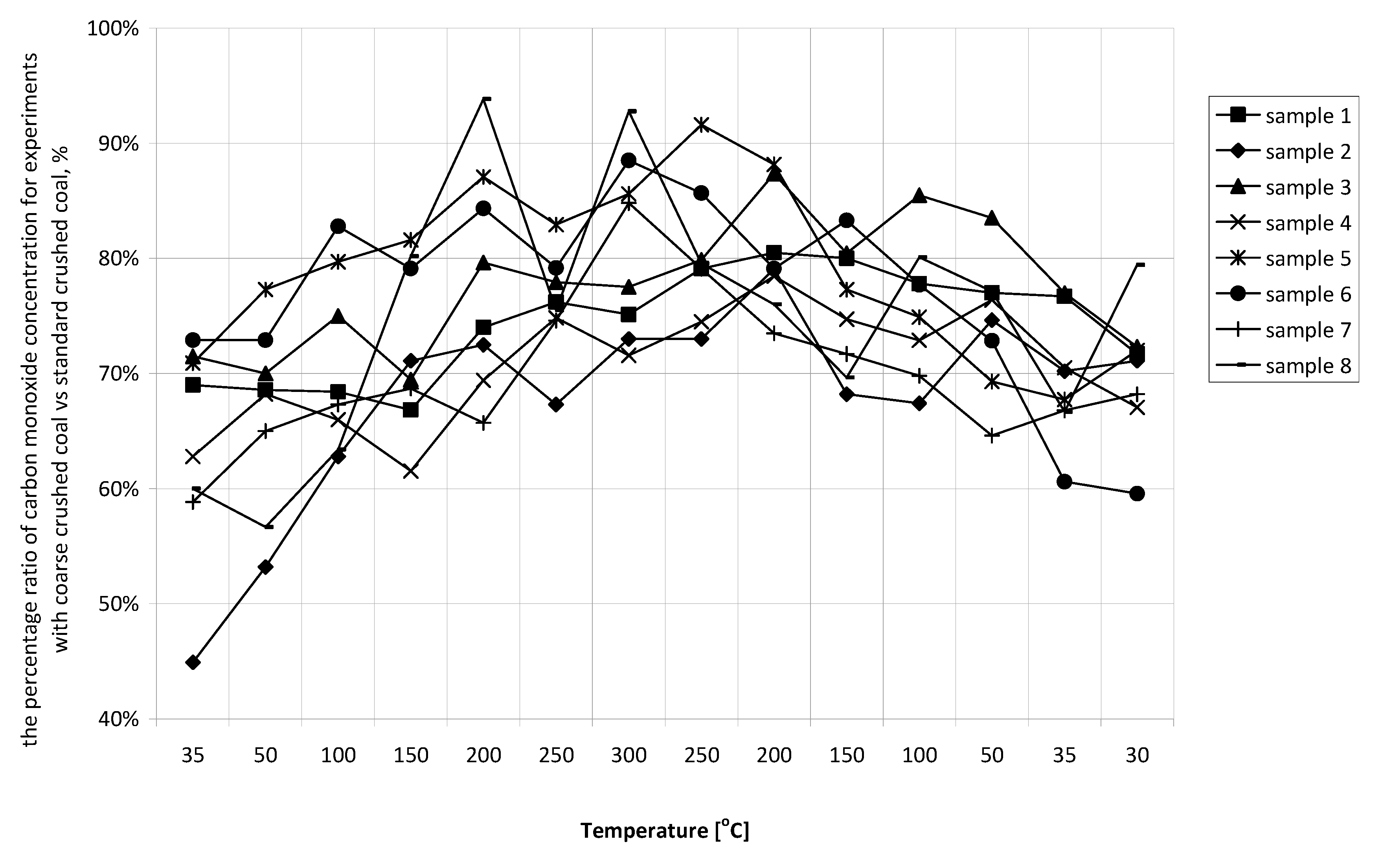
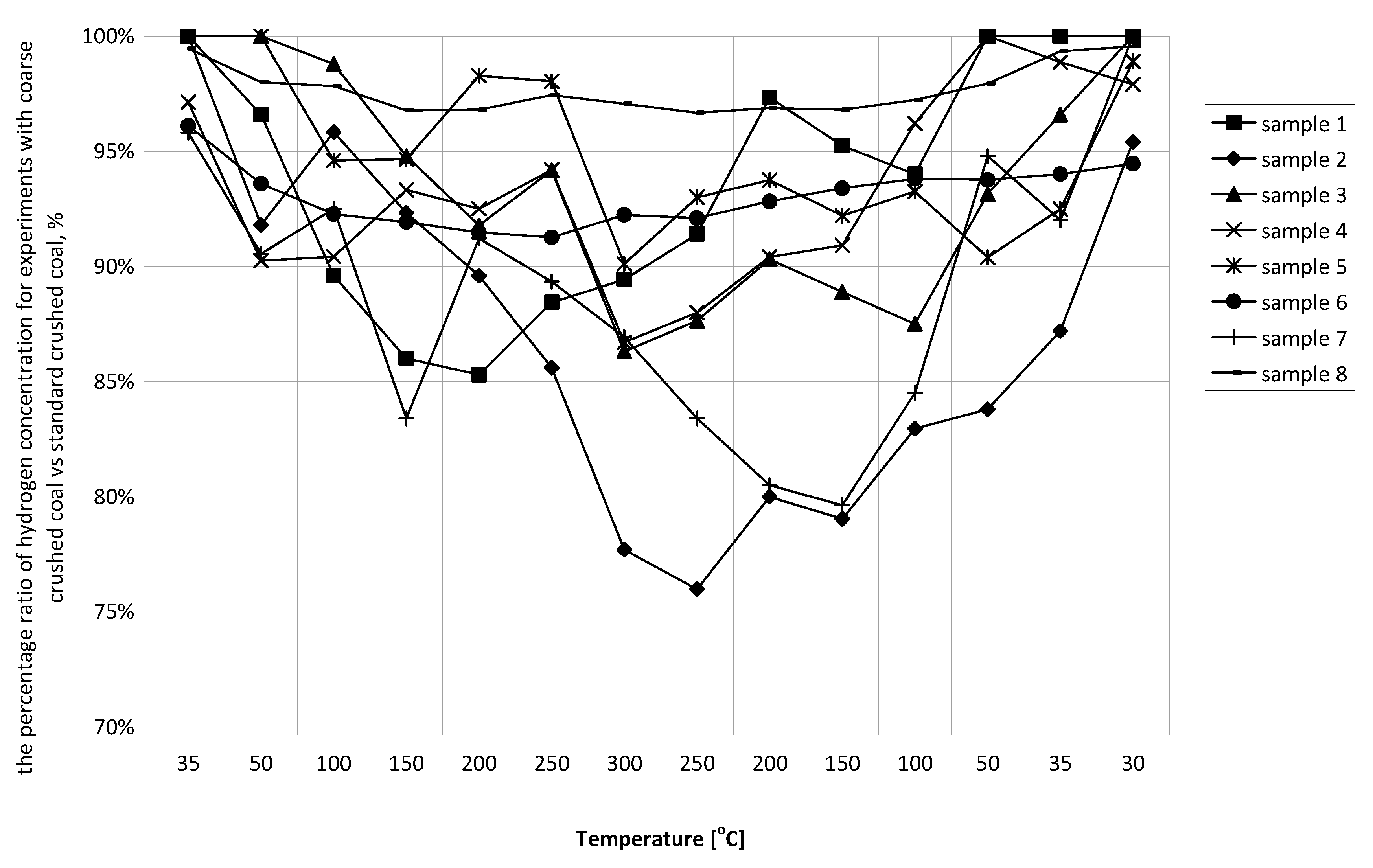
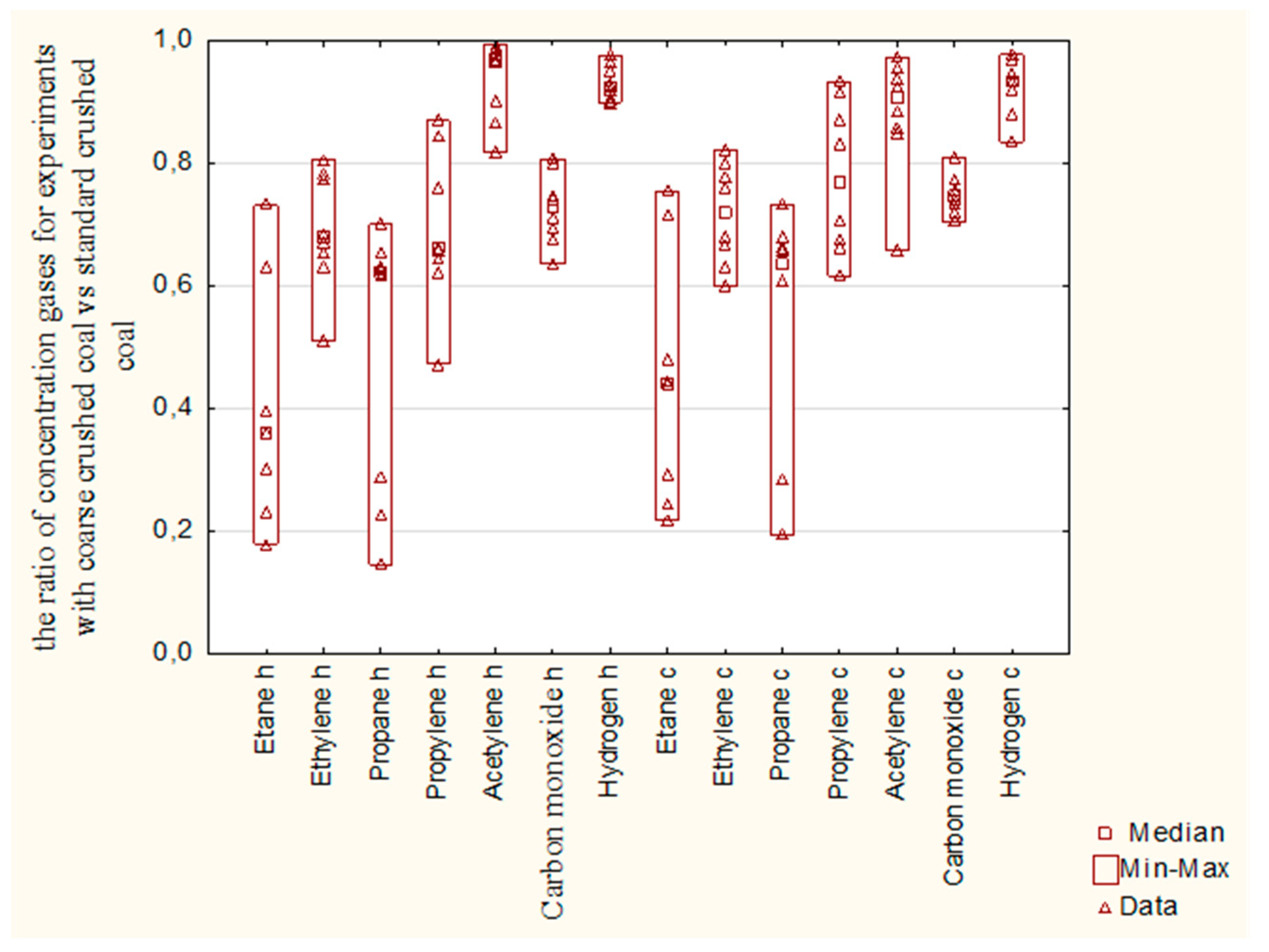
| Sample No. | Transient Moisture, % w/w | Moisture, % w/w | Ash, % w/w | Volatiles, % w/w | Carbon, % w/w | Sulphur, % w/w | Hydrogen, % w/w | Nitrogen, % w/w | Oxygen, % w/w | Self-Ignition Index *A, kJ/mol | Self-Ignition Index **Sza, °C/min | Self-Ignition Group |
|---|---|---|---|---|---|---|---|---|---|---|---|---|
| 1 | 3.6 | 4.4 | 8.2 | 32.1 | 72.7 | 0.9 | 4.7 | 1.3 | 7.6 | 52 | 105 | IV |
| 2 | 1.2 | 0.8 | 4.2 | 23.0 | 87.8 | 0.5 | 3.2 | 1.1 | 8.3 | 60 | 42 | II |
| 3 | 4.9 | 3.1 | 7.8 | 28.7 | 72.9 | 0.6 | 4.1 | 1.0 | 8.2 | 54 | 109 | IV |
| 4 | 2.7 | 2.6 | 3.9 | 27.9 | 78.7 | 0.4 | 4.4 | 1.4 | 8.3 | 52 | 97 | III |
| 5 | 8.8 | 9.2 | 4.9 | 34.1 | 70.6 | 1.1 | 4.7 | 0.8 | 12.3 | 47 | 135 | V |
| 6 | 1.8 | 1.1 | 4.1 | 22.9 | 88.1 | 0.5 | 4.6 | 1.2 | 4.2 | 66 | 45 | I |
| 7 | 1.6 | 1.2 | 4.7 | 26.5 | 84.5 | 0.4 | 4.4 | 1.6 | 4.6 | 69 | 53 | I |
| 8 | 1.7 | 1.3 | 7.5 | 33.9 | 83.8 | 1.0 | 5.4 | 1.4 | 3.4 | 65 | 62 | II |
© 2020 by the authors. Licensee MDPI, Basel, Switzerland. This article is an open access article distributed under the terms and conditions of the Creative Commons Attribution (CC BY) license (http://creativecommons.org/licenses/by/4.0/).
Share and Cite
Więckowski, M.; Howaniec, N.; Smoliński, A. Assessment of Heating and Cooling of a Spontaneous Fire Source in Coal Deposits—Effect of Coal Grain Size. Minerals 2020, 10, 907. https://doi.org/10.3390/min10100907
Więckowski M, Howaniec N, Smoliński A. Assessment of Heating and Cooling of a Spontaneous Fire Source in Coal Deposits—Effect of Coal Grain Size. Minerals. 2020; 10(10):907. https://doi.org/10.3390/min10100907
Chicago/Turabian StyleWięckowski, Marek, Natalia Howaniec, and Adam Smoliński. 2020. "Assessment of Heating and Cooling of a Spontaneous Fire Source in Coal Deposits—Effect of Coal Grain Size" Minerals 10, no. 10: 907. https://doi.org/10.3390/min10100907
APA StyleWięckowski, M., Howaniec, N., & Smoliński, A. (2020). Assessment of Heating and Cooling of a Spontaneous Fire Source in Coal Deposits—Effect of Coal Grain Size. Minerals, 10(10), 907. https://doi.org/10.3390/min10100907






